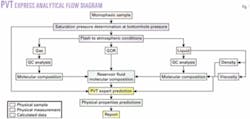New tools and services allow companies to shorten the time required to sample and evaluate reservoir fluids encountered in deepwater exploration and appraisal wells.
With deepwater drilling costs often in the $400,000/day range and regulations in place that restrict flaring in many deepwater areas, these new approaches save costs as well as provide, in many cases, sufficient fluid samples and pressure data for estimating a reservoir's production potential.
For instance, Unocal Corp. in its No. 4 appraisal well at Champlain in Gulf of Mexico Block Atwater Valley 63, recently used Schlumberger Oilfield Services' new on site pressure-volume-temperature (PVT) analysis equipment (PVT Express) to speed the characterization of fluids recovered with a modular formation dynamic tester (MDT).
Unocal needed the on site analysis because, as explained by Gregory R. Andersen, consulting petroleum engineer with Unocal, "We had some issues about determining whether we had reservoir fluids in the previous well and we wanted to shorten the time on the PVT analysis of the fluid. We also wanted to obtain samples with low drilling fluid contamination levels with which we could perform flow assurance work."
He expects the on site PVT equipment to be used on an upcoming Gulf of Mexico deepwater well and may also analyze gas-condensate samples obtained from a planned drillstem test on a deepwater well in Indonesia. "We want to use it again because we can see the utility in this," he added.
Champlain prospect
Unocal said July 21, 2003, the Champlain well, drilled from the Discoverer Spirit drillship in 4,418 ft of water, was completed in 78 days at a gross cost of $41.8 million and reached a vertical TD of 27,869 ft subsea.
The company is working on potential development concepts for the field. Texaco Inc. drilled the discovery well in the field in 2000.
Deepwater operators use oil-based drilling fluids because of their enhanced drilling performance. The oil-based mud, commonly, however, contaminates fluid samples and therefore complicates fluid sample analysis.
As in most deepwater wells in the gulf, Unocal retrieves reservoir samples and obtains reservoir pressures with tools such as Schlumberger's MDT. Andersen said most operators would like to keep the drilling fluid filtrate contamination to less than 10% in the samples and preferably near 5%. He described the operation in the Champlain well as:
First making a normal logging run to determine what is pay.
Next running the MDT to obtain pressure measurements to understand the reservoir continuity.
Then running the MDT to obtain fluid samples in 250 ml, 450 ml, and 2-3 gal containers. In Champlain 4, Unocal made two six-pack runs, with each run also including one large volume container per run, resulting in 26 total samples being taken.
Andersen said a typical way to take fluid samples is to pump through the tool for an extended period of time from 30 min to a couple of hours until the oil analyzer on the tool indicates that the fluid has cleaned up and that it contains a minimal amount of contamination from drilling mud filtrate. The run usually includes taking a series of samples, even at the same depth, in case of container failure.
Some containers are pressure compensated while others are not. Andersen said one needs the pressure-compensated samples for flow assurance work in case the reservoir fluid contains asphaltenes. These asphaltenes would drop out of nonpressurized containers because of changes in pressure and temperature as the container is brought to surface.
Andersen said the first samples analyzed from the Champlain well were from the target zone and the analysis was directed at determining if it was the same fluid as found in previous appraisal wells.
Unocal expected a turnaround of less than 12 hr for the PVT analysis, but the analysis took 36 hr because of difficulties in determining the drilling fluid contamination. A post well review was performed and areas of improvement were identified. Andersen expects future analysis turnarounds of about 3 hr.
On site PVT
Schlumberger describes its wellsite fluid analysis service (PVT Express) as needing less than 50 ml of fluids for an analysis compared to traditional PVT services conducted in onshore laboratories that require 200-4,000 ml of fluid and take between 6 to 8 weeks to complete the analysis and fluid measurements.
The on site PVT laboratory includes fiber-optic sensors to measure saturation pressure of gas condensates, volatile oils, and black oils. Patented helium ionization detectors are used in dual gas chromatography to perform C12+ gas analysis and C36+ liquid analysis. Fig. 1 shows a flow diagram of the analysis process.
The PVT equipment is mercury-free and Schlumberger says its modular rugged construction allows it to be fully transportable by land, sea, or air.
A proprietary software model processes all laboratory measurements and provides the final PVT report including an assessment on data reliability.


